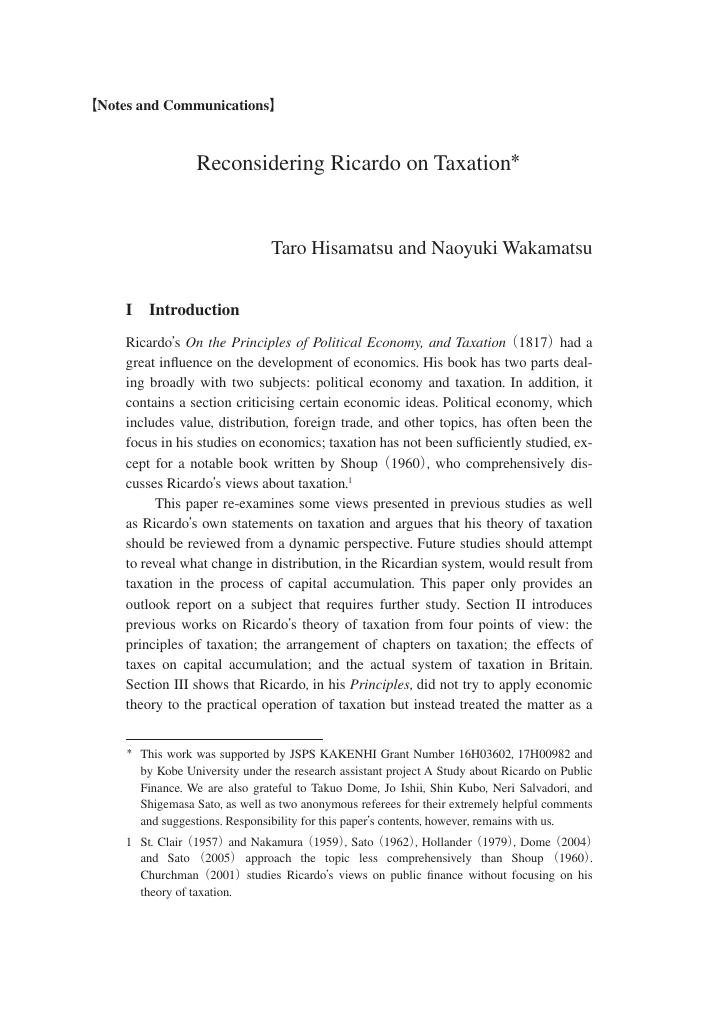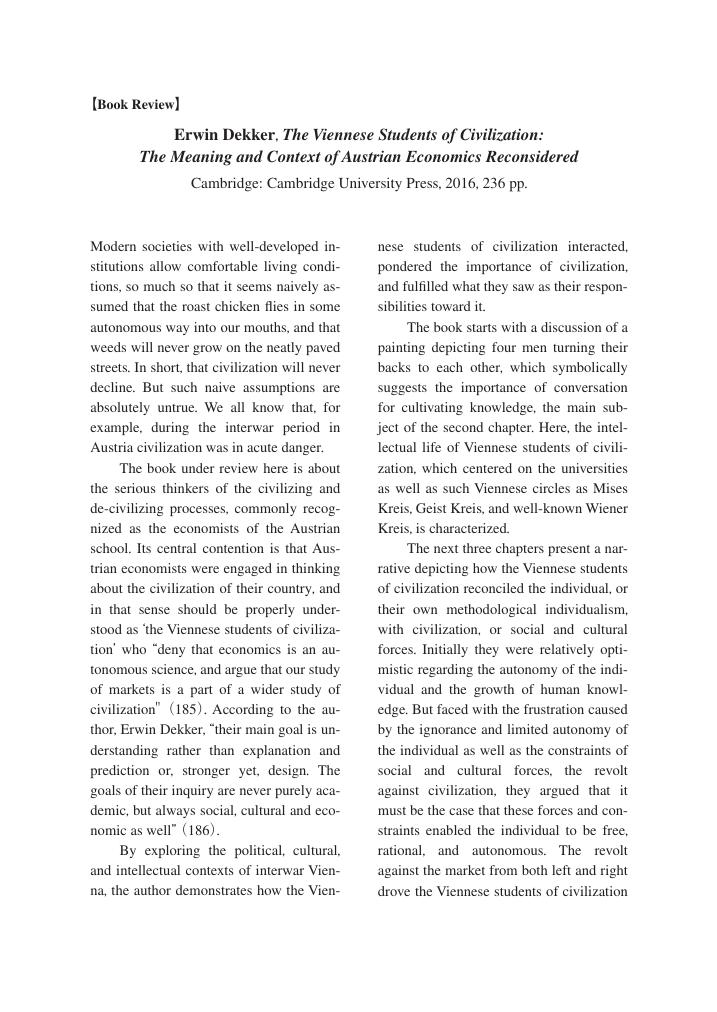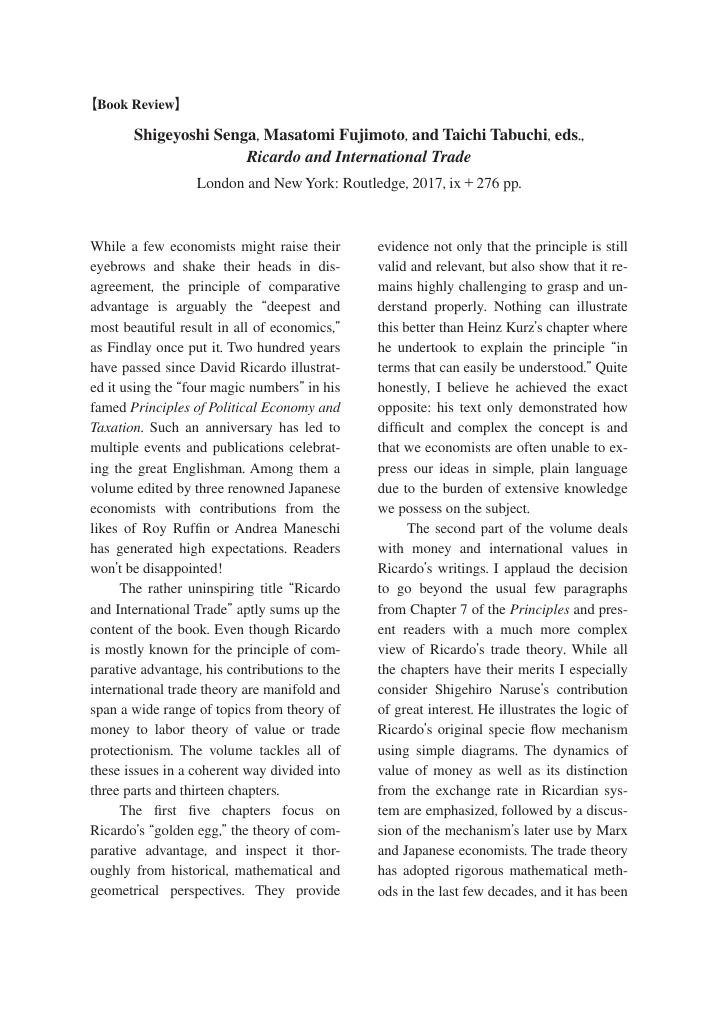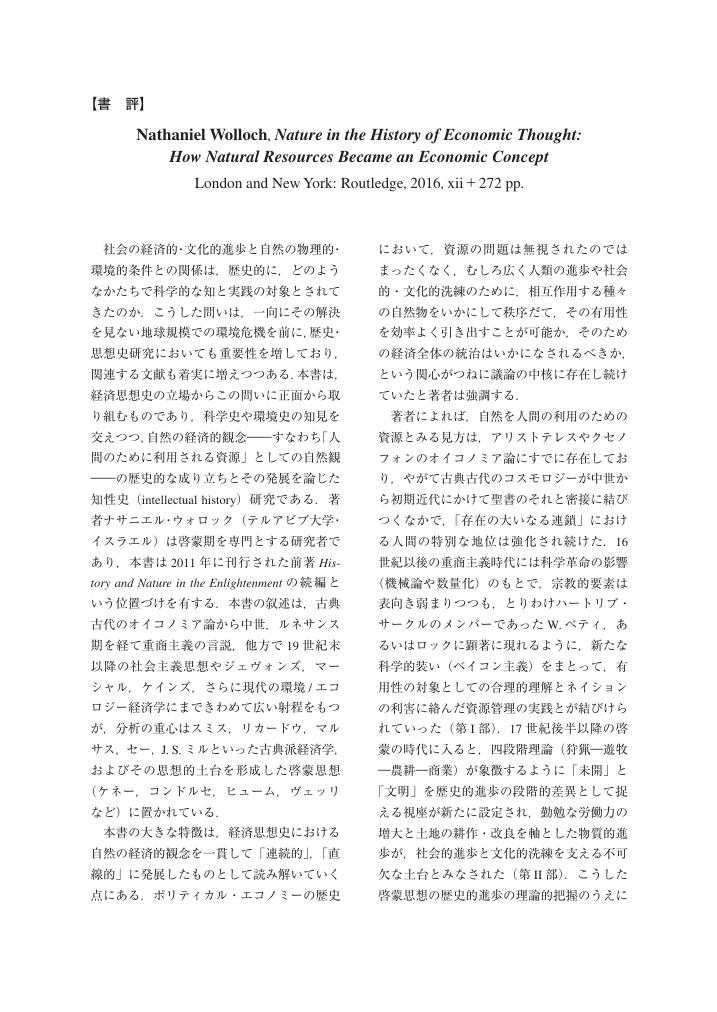- 著者
- 若森 章孝
- 出版者
- 経済学史学会
- 雑誌
- 経済学史研究 (ISSN:18803164)
- 巻号頁・発行日
- vol.60, no.1, pp.207-208, 2018 (Released:2019-11-05)
1 0 0 0 OA 菱山泉訳 スラッファ『経済学における古典と近代』
- 著者
- 菱山 泉 宮本 順介 Robert Chapeskie
- 出版者
- The Japanease Society for the History of Economic Thought
- 雑誌
- 経済学史研究 (ISSN:18803164)
- 巻号頁・発行日
- vol.60, no.2, pp.42-96, 2019 (Released:2019-09-04)
Introduction by Junsuke Miyamoto In 1956 Izumi Hishiyama and Yoshihiro Taguchi translated two essays by Piero Sraffa, ʻSulle relazioni fra costo e quantità prodottaʼ (1925) and ʻThe Laws of Returns under Competitive Conditionsʼ (1926), and published them, with the addition of commentary by Hishiyama, as Keizaigaku ni okeru Koten to Kindai-Shinkotengakuha no Kentō to Dokusenriron no Tenkai (The Classical and the Modern in Economics: The Examination of the Neoclassical School and the Development of Monopoly Theory, Tokyo: Yuhikaku) in the same year. It is the commentary by Hishiyama included in this book, ʻSraffaʼs Position in the History of Economic Thought and the Significance of his Study of Ricardo,ʼ that has been translated into English here. Izumi Hishiyama (1923-2007) began his work as a scholar with the study of François Quesnayʼs tableau économique, and the results of these efforts were brought together in ʻThe Tableau Économique of Quesnay: Its Analysis, Recon-struction and Applicationʼ (Kyoto University Economic Review, April 1960). This work received international acclaim as the first thoroughgoing attempt at a dynamic treatment of the tableau économique model. Later, Hishiyama en-countered Sraffaʼs essay ʻSulle relazioni fra costo e quantità prodotta,ʼ which made a profound impression on him, and through the intermediary of Sraffa developed an interest in classical school economics centred on David Ricardo, on the one hand, and the economics of Alfred Marshall and the Cambridge school, on the other. On the basis of an approach that involved reviving the ideas of the classical school in modern economics, Hishiyama presented a large amount of excellent research ranging from the economics of the classical school to the economics of his day. He is renowned in particular as a pioneer of Sraffian economics in Japan, and in 1962 published, together with Hiroshi Yamashita as his co-translator, a groundbreaking Japanese translation of Production of Commodities by Means of Commodities: Prelude to a Critique of Economic Theory (1960), one of Sraffaʼs most important works. In 1993 he published Sraffa Keizaigaku no Gendaiteki Hyōka (A Modern Evaluation of Sraffian Economics, Kyoto: Kyoto University Press), a text that can be described as one of his most significant works, in which he considered Sraffaʼs economics from a multi-layered perspective and attempted to establish his contribution to modern economics.
1 0 0 0 OA Reconsidering Ricardo on Taxation
- 著者
- 久松 太郎 若松 直幸
- 出版者
- The Japanease Society for the History of Economic Thought
- 雑誌
- 経済学史研究 (ISSN:18803164)
- 巻号頁・発行日
- vol.60, no.2, pp.97-101, 2019 (Released:2019-09-04)
1 0 0 0 OA ケインズと精神医学
- 著者
- 山崎 好裕
- 出版者
- 経済学史学会
- 雑誌
- 経済学史研究 (ISSN:18803164)
- 巻号頁・発行日
- vol.60, no.2, pp.106-110, 2019 (Released:2019-09-04)
- 著者
- 荒川 憲一
- 出版者
- 経済学史学会
- 雑誌
- 経済学史研究 (ISSN:18803164)
- 巻号頁・発行日
- vol.60, no.2, pp.111-112, 2019 (Released:2019-10-14)
- 著者
- 中井 大介
- 出版者
- The Japanease Society for the History of Economic Thought
- 雑誌
- 経済学史研究 (ISSN:18803164)
- 巻号頁・発行日
- vol.60, no.2, pp.113-114, 2019 (Released:2019-10-14)
1 0 0 0 OA 初期コモンズの通貨制度改革構想
- 著者
- 寺川 隆一郎
- 出版者
- 経済学史学会
- 雑誌
- 経済学史研究 (ISSN:18803164)
- 巻号頁・発行日
- vol.60, no.2, pp.20-41, 2019 (Released:2019-09-04)
- 被引用文献数
- 1 1
Abstract: While John R. Commons (1862―1945) is well known for his studies on American labor and Anglo-American economic law, even researchers of the history of economic thought are unfamiliar with his career-long devotion to the study of monetary questions. It was not until the 1990s that a few researchers discovered that Commons, in his later years, developed the concept of endogenous money, according to which money is a dynamic process that gets created, transferred, and extinguished alongside ongoing economic transactions. However, it is still unclear how he developed the concept in his long career as an economist. To tackle this question, this study focuses on Commons in his earliest days and reexamines his works on monetary reform published in the aftermath of the financial panic of 1893. The salient features of Commons’ money reform plan can be summarized as follows: (1) adopting “bullion notes” as base monies that are redeemable in silver at its market price, and (2) establishing a monetary commission that compiles the price index and accordingly keeps the average price at a constant level through the silver bullion open market operations. To understand the true scope of the plan, this study revisits its historical context, that is, the establishment of the international gold standard after 1873, the 1893 banking and dollar crisis, and the debate on the national banking currency after the crisis. It eventually demonstrates Commons’ early theory of money and credit, which underlies his reform plan. The study finds that Commons takes a nominalist position on the nature of money, adopts an endogenous approach on credit money supply, and recognizes a governmental role in credit administration in his money reform plan. JEL classification numbers: B15, B31, E42.
本研究は、日本における景品・懸賞付販売に対する規制のあり方について、消費者視点から考察を行うことを目的としたものである。研究成果のとりまとめは、平成16年度に実施した全国2794の消費者団体に対して行ったアンケート調査(897団体から回答)のデータ分析と、比較法的視点に基づく諸外国-特に、EC、ドイツ、アメリカーの法制度の調査を中心に行われた。前者は、既にアンケート項目毎の集計データを基に、日常の消費生活における景品・懸賞付販売およびオープン懸賞との関わり、購入または応募の頻度、景品・懸賞企画による対消費者の誘引効果、現行法による規制に対する消費者意識についての実態把握と分析が主体となっている。調査対象は、一般消費者に比べて、問題意識が高く専門的知見を有する消費者団体であるが、分析結果から、かかる対象者においても、取引の場面で景品・懸賞に誘引されている傾向が見られる点、また同時に圧倒的多数が景品・懸賞付販売に対する規制が今後も必要であると考えている点が明らかになったが、このような取引実態と規制に対する意識を踏まえた望ましい法規制のあり方を今後検討する必要がある。後者は、諸外国における景品・懸賞付販売に対する法規制の状況に目を向け、日本における法規制のあり方を検討する上での何らかの手がかりを得ようとするものであった。ここで明らかにされたことは、諸外国においては、「景品付販売」と「懸賞付販売」を区別して規制を行っている点、ほとんどの国において「懸賞付販売」は原則禁止されており、「景品付販売」についてはそれぞれの国ごとで規制が異なっている点であり、両者を区別せず、一定の価額以下では原則自由の日本の規制制度を再検討する重要な手がかりとなった。今後は、ほとんどの国で原則禁止されている「射倖心を利用する事業活動」に対する日本における規制のあり方について、競争法のみならず、多面的な観点から考察する予定である。
- 著者
- 北田 了介
- 出版者
- 経済学史学会
- 雑誌
- 経済学史研究 (ISSN:18803164)
- 巻号頁・発行日
- vol.60, no.1, pp.189-190, 2018 (Released:2019-11-05)
- 著者
- 尾近 裕幸
- 出版者
- The Japanease Society for the History of Economic Thought
- 雑誌
- 経済学史研究 (ISSN:18803164)
- 巻号頁・発行日
- vol.60, no.1, pp.191-192, 2018 (Released:2019-11-05)
- 著者
- 藤田 菜々子
- 出版者
- 経済学史学会
- 雑誌
- 経済学史研究 (ISSN:18803164)
- 巻号頁・発行日
- vol.60, no.1, pp.193-194, 2018 (Released:2019-11-05)
- 著者
- Martin Grančay
- 出版者
- The Japanease Society for the History of Economic Thought
- 雑誌
- 経済学史研究 (ISSN:18803164)
- 巻号頁・発行日
- vol.60, no.1, pp.195-196, 2018 (Released:2019-11-05)
- 著者
- 桑田 学
- 出版者
- 経済学史学会
- 雑誌
- 経済学史研究 (ISSN:18803164)
- 巻号頁・発行日
- vol.60, no.1, pp.199-200, 2018 (Released:2019-11-05)
- 著者
- 山根 卓二
- 出版者
- 経済学史学会
- 雑誌
- 経済学史研究 (ISSN:18803164)
- 巻号頁・発行日
- vol.60, no.1, pp.197-198, 2018 (Released:2019-11-05)
- 著者
- 伊藤 宣広
- 出版者
- 経済学史学会
- 雑誌
- 経済学史研究 (ISSN:18803164)
- 巻号頁・発行日
- vol.60, no.1, pp.201-202, 2018 (Released:2019-11-05)
- 著者
- 池田 幸弘
- 出版者
- 経済学史学会
- 雑誌
- 経済学史研究 (ISSN:18803164)
- 巻号頁・発行日
- vol.60, no.1, pp.203-204, 2018 (Released:2019-11-05)
- 著者
- 玉手 慎太郎
- 出版者
- 経済学史学会
- 雑誌
- 経済学史研究 (ISSN:18803164)
- 巻号頁・発行日
- vol.60, no.1, pp.205-206, 2018 (Released:2019-11-05)
- 著者
- 加藤 健
- 出版者
- 経済学史学会
- 雑誌
- 経済学史研究 (ISSN:18803164)
- 巻号頁・発行日
- vol.60, no.1, pp.20-39, 2018 (Released:2019-09-03)
Abstract: This study discusses the content of the “Wisconsin Idea.” It attempts to examine John R. Commonsʼs view on this idea and his influence on several social reforms, and it tracks how an active role played by economists led to the application of this idea to the American social reforms. Commons took part in the social gospel movement under the guidance of Richard T. Ely. As a member of this movement, Commons worked towards the achievement of social and political reforms rooted in Christianity and social sciences. According to Frederic C. Howe (1912), in the 1910s, Wisconsin was regarded as an American state likely to accept German social reforms. During this Progressive Era, in Wisconsin, several social and political reforms were executed based on the “Wisconsin Idea,” which was named such by Charles McCarthy (1912). The idea was developed by several brain trusts under the governor Robert M.La Follette. As a member of one of these brain trusts, Commons was also involved in sev-eral social reforms. Owing to his experience not only as a former social gospeler but also as a member of such a brain trust, Commons attempted to improve social welfare through the en-actment of legal rules based on cooperation between the state university and the state govern-ment. Without this cooperation, it would not have been possible to establish the comprehen-sive social legislation in Wisconsin. Commonsʼs analysis reveals that, through the expansion of university extension pro-grams, it was possible to enhance the professional ethics of workers and improve the social welfare of their community, and that there was a need for the associated economists to recog-nize the permanent interests of the nation to adopt appropriate social reforms. Therefore, it would not be an exaggeration to state that Commons was the very embodiment of the “Wis-consin Idea.” JEL classification numbers: B 15, I 38, N 93.
- 著者
- 田淵 太一
- 出版者
- The Japanease Society for the History of Economic Thought
- 雑誌
- 経済学史研究 (ISSN:18803164)
- 巻号頁・発行日
- vol.60, no.1, pp.79-99, 2018 (Released:2019-09-03)
- 被引用文献数
- 2
Abstract: This paper presents a new interpretation of Ricardo’s international trade theory. It shows that Ricardo’s value theory in his Principles can be understood exclusively as the cost-of-production theory of value, which integrates the domestic value theory and international value theory, requisitely taking into consideration changes in the value of money when it is applied to the analysis of international exchange. In Section II, we critically re-examine the standard interpretation of Ricardo’s trade theory in the so-called ‘Ricardian Model’ in textbooks today. Based on the concepts of ‘comparative advantage’ and ‘gains from trade’ within the two-country two-commodity framework, we show that it is a distorted interpretation, which originated from J. S. Mill’s arguments and established through the debate between Viner and Haberler, in the opposite direction of Ricardo’s original value theory. In Section III, we present that Ricardo consistently adopted the cost-of-production theory of value, which is valid not only for domestic, but also international, exchange based on the concept of natural price, with the so-called ‘labour theory of value’ being merely a subset rule in the analysis of domestic exchange. We then show that Ricardo’s original value theory inevitably takes into consideration the differences and adjustments in the value of money in international exchange, in the analysis of international exchange. Finally, we will briefly review that Ricardo was heading in the right direction towards today’s theory of international trade including intermediate goods. JEL classification numbers: B 12, B 17.
- 著者
- 内山 隆
- 出版者
- The Japanease Society for the History of Economic Thought
- 雑誌
- 経済学史研究 (ISSN:18803164)
- 巻号頁・発行日
- vol.60, no.1, pp.171-178, 2018 (Released:2019-09-03)














